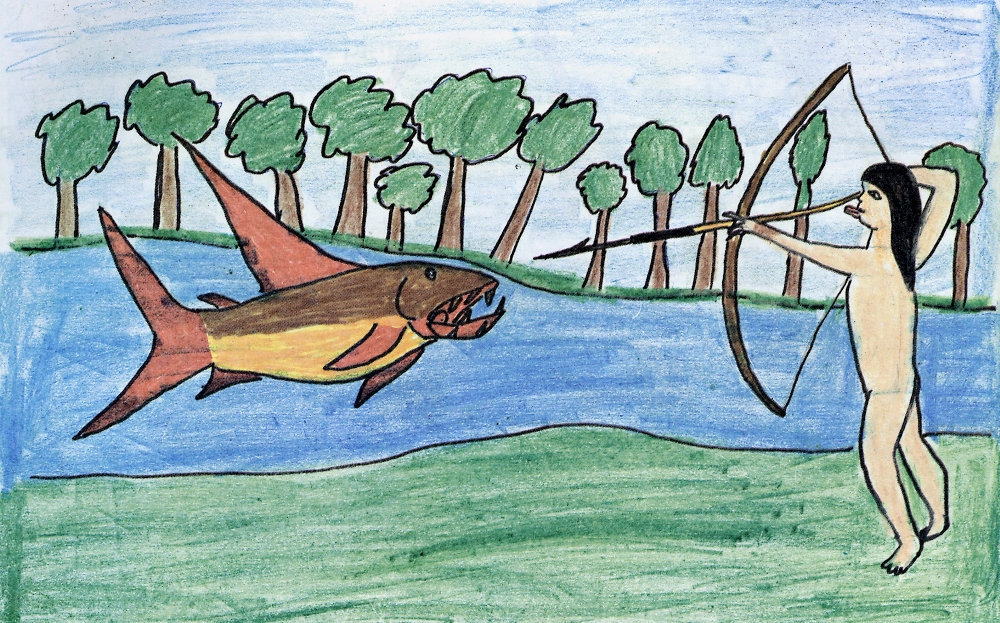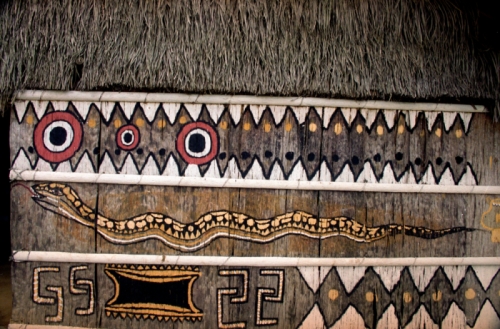Myths and cosmology
Text based on the articles Indigenous myths and cosmologies in Brazil: a short introduction (1992) and Myth, reason, history and society (1995) by Aracy Lopes da Silva
What are myths?
One of the ways in which specialists usually conceive of myths defines them as oral narratives that contain truths deemed fundamental to a people (or social group) and that form a set of stories devoted to recounting the adventures of heroes who lived at the beginning of time (in the time of myth or origins) when everything was created and the world ordered. What is emphasized from this perspective is the narrative form assumed by the myths.
The myth (in the singular) can also be defined as a specific level of language, a special way of thinking and expressing categories, concepts, images and notions connected in stories whose episodes can be easily visualized. The myth, then, is perceived as a way of exercising thought and expressing ideas. What, though, are its distinctive features?
These two definitions agree in terms of their essential aspects. Firstly, both emphasize that myths say something and something important, something to be taken seriously. Secondly, both also highlight the fact that one of the specificities of myth resides in its way of formulating, expressing and ordering ideas and images though which a discourse is constituted and a story narrated. Finally, both definitions suggest a particular relation between myth (or myths), the way of living and thinking and the history of the peoples responsible for its existence.
What do myths speak about?
The indistinction between humans and animals who relate to each other as equals; sky and earth close to each other, almost touching; cosmic journeys, humans who fly, primeval twins, creator insects; subterranean origins; floods, subaquatic human beings; chaos, conquests, transformations... Myths describe the world taking shape, defining places and the characteristics of figures known today.
The mythic themes narrate adventures and primordial beings in a language built through concrete images that can be captured by the senses; situated in a time of origins but referring to the present, containing future prospects and carrying experiences of the past. In other words, myths are complex entities.
Myths are also extremely varied since they are original creations of each group with their own cultural identity, referring to their conditions of existence and their specific cosmovision. But it is equally undeniable that myths form variations of common themes, shared not only locally but, in some cases, universally. Particular and local, universal and essentially human. Perhaps this is where some of the fascination and mystery of myths resides.
In the specific sociocultural universes constituted by each individual indigenous society, the myths are connected to the group’s social life, rituals, history and philosophy with locally developed categories of thought that result in specific ways of conceiving the human person, time, space and the cosmos. This is the level at which the attributes of personal and group identity are defined, what is distinctive and exclusive, and constructed in contrast to what is defined as ‘other:’ nature, the dead, enemies, spirits.
Myth is central to the definition of humanity and its place in the cosmic order in contraposition to other domains – inhabited and controlled by other kinds of beings – seen, sometimes, as different moments of a continuous process of producing life and the world. In this conception of the cosmos, there is order, classification, logical opposition, hierarchy, inclusive and exclusive categories. But there is also movement and a continual play with time, whether to suppress it, enabling living humans to re-encounter the past and their ancestors and origins, or to turn it into an axis of existence itself, destined to be completed and fully constituted after death in the eternal transcendence of the limits of the human condition.
Myth and society
Myths are a place for reflection: they speak of the complex philosophical problems with which human groups must deal. They have multiple layers of meaning and are repeatedly told during the lifetime of individuals who, as they mature socially and intellectually, discover new and unsuspected meanings in the same stories, hidden below the already known and understood layers.
This is how indigenous societies manage to present knowledge, reflections and essential truths in a language that is accessible even to children, who enter into contact with questions whose complexity they gradually come to discover and comprehend.
For all these reasons, myths are difficult to comprehend fully. The truths they express and the conceptions they contain, though touching on questions relevant to all of humanity, are articulated in the values and meanings unique to each society and culture. To understand the latter, therefore, requires a fairly dense knowledge of the sociocultural contexts that serve as reference points for the ideas contained in each myth.
The myths speak about social life and the way in which it is organized and conceived in a particular society. They don't simply reflect the latter: they problematize it, turning it into an object to be questioned and provoking reflection on the reasons for the social order. They can – and indeed very often do – end up reaffirming it (Lévi-Strauss 1976), but this does not unfold in a mechanical form.
Myth and history
Myth, like culture, is alive. At once the product and tool of knowledge and reflection on the world, society and history, it incorporates the constant flux of processes in which social life unfolds as its themes. Myths are collectively elaborated products in which new situations are incorporated and made meaningful (for examples of these processes, see 1993 and Lopes da Silva 1984).
Myths are part of a people’s tradition. However, tradition is continually recreated, otherwise it would lose its meaning and become mere reminiscence rather than the memory of past experiences turned into living reference points for the present and future. Myths, therefore, maintain a relation of exchange with history, recording facts, interpretations, sometimes reducing the new to the known or, inversely, allowing themselves to be swept up by events, transforming with them (Sahlins 1989; Fausto 1992).
Until recently, indigenous societies were understood by scholars to be societies ‘without history.’ These societies were imagined to focus on the mythic past, employing their creativity to remain the same, denying the flow of history, neutralizing transformations and recognizing as processes only those that recompose the model traditionally followed. This was how they were conceived during the early phases of anthropological studies and, due to this fact, were defined as “traditional, sacred and self-enclosed” societies, immune to change. From this viewpoint, indigenous peoples only ‘entered History’ when they first made contact with ‘Whites’ as participants of Western history.
These ideas were later inevitably revised. They were seen to promulgate an ethnocentric viewpoint that impeded the comprehension of native societies in their own terms. We know today (and this is a theme of numerous contemporary research projects) that human cultures develop distinct historical logics as ways of thinking, relating to and experiencing historical processes.
A panorama of diversity
We can turn to some more concrete instances of specifically indigenous ways of conceiving the cosmos and situating oneself within it. The examples that follow are provided here merely as a starting point.
Jê peoples

Among peoples from the Jê linguistic family, the cosmos is conceived to be inhabited by different humanities – subterranean, terrestrial, subaquatic and celestial – who have existed since the beginning of time. The time of origins is that of the indistinction, disorder, cohabitation and interpenetration of these later separate domains. Astral bodies, such as the Sun and Moon, are primordial twins who pursue adventures on earth and leave behind their legacy before departing to their eternal dwelling place. In the Jê myths, there are explicit references to subsistence activities and social practices in general. The origins of social institutions – the naming of individuals, warfare, shamanism – are described in myths and their essence made explicit.
Peoples of the Upper Rio Negro

As a contrasting case we can cite the region of the Upper Rio Negro, Northwest Amazonia, the home of Tukano-speaking peoples. At the beginning of time, mythic ancestors brought the world into existence. The first ancestors emerged from the entrails of a giant ancestral snake, which followed the route of the river. Each ancestor of the various peoples of the region emerged at a precise point on the route, thereby determining their respective territories, their specific characteristics and the hierarchized relationship between them.
In many cosmologies, the relations between humans and other beings are conceived through the idea of predation in a metaphor that symbolically and logically approximates hunting, warfare, sex and commensality. Still on the Upper Rio Negro, the shaman seems to be assigned responsibility for ensuring that flows and volumes of vital energy shared by humans and animals are kept at suitable levels. Any exaggerated culling of animals will lead to a retaliatory response in the form of epidemics and afflictions among humans provoked by the animals’ protector spirits. A vital equilibrium in memories and intimacy with the idea of death are central to the ways in which people experience, appreciate and conduct their day-to-day lives.
Tupi-Guarani peoples
For more than 550 years, non-Indians have produced analyses attempting to comprehend the social practices and cosmological conceptions of the Tupi-Guarani. From the initial shock to Jesuit missionization and the dramatic episodes of the Conquest and finally the systemization of the information from the chroniclers undertaken in the 1940s and 50s, we encounter the constant references to the themes of warfare, cannibalism and the avenging of death through new wars, new deaths and new acts of revenge.
An understanding of these peoples, their societies and their cosmologies, responding to the recent theoretical and methodological maturation of anthropology, reveals – despite the great diversity existing between them both at a sociological level and in terms of the variations between their respective cosmovisions – the centrality of the notion of temporality as an axis on which fundamental notions of the person and cosmos are built. Temporality is allied to the relations of alterity that Tupi-Guarani peoples systematically look to situate beyond the social domain properly speaking, embodied in enemies, spirits, animals, the dead and the divinities.
Sources of information
- FAUSTO, Carlos. “Fragmentos de História e Cultura Tupinambá: da etnologia como instrumento crítico de conhecimento etno-histórico”. In: CARNEIRO DA CUNHA, M. (org.). História dos Índios no Brasil. São Paulo, Cia das Letras/Edusp/SMC, 1992
- GALLOIS, Dominique. Mairi Revisitada. São Paulo, NHII-USP/Fapesp, 1993.
- LALLEMAND, Suzanne. “Cosmogonia”. In: AUGÉ, M. (org.) A construção do mundo. Edições 70, Lisboa, 1978.
- LEACH, Edmund. “O Gênensis enquanto um mito”. In: Edmund Leach (org. Roberto da Matta), Ed. Ática/Grandes Cientistas Sociais/Antropologia 38, 1983, pp. 57-69.
- LÉVI-STRAUSS, C. “A gesta de Asdiwal”. In: Antropologia Estrutural Dois, Ed. Tempo Brasileiro, Rio de Janeiro, 1976.
- LOPES DA SILVA, Aracy. “A expressão mítica da vivência histórica: tempo e espaço na construção da identidade xavante”. In: Anuário Antropológico/82, Tempo Brasileiro/Universidade Federal do Ceará, Rio de Janeiro e Fortaleza, 1984. ------. “Mitos e cosmologias indígenas no Brasil: breve introdução”. In: Índios no Brasil. Grupioni, Luís Donisete Benzi (org.). São Paulo, Secretaria Municipal de Cultura, 1992. ------. “Mito, razão, história e sociedade”. In: LOPES DA SILVA & GRUPIONI (orgs.). A Temática Indígena na Escola. Brasília, MEC/MARI/Unesco, 1995.
- SAHLINS, Marshall. Ilhas de História. São Paulo, Cultrix, 1989.
- VIDAL, Lux. Grafismo Indígena. Estudos de Antropologia Estética. São Paulo, Studio Nobel/Fapesp/Edusp, 1992.
- VIVEIROS DE CASTRO, E. & CARNEIRO DA CUNHA, M. “Vingança e Temporalidade: os Tupinambá”. In: Anuário Antropológico/85, Ed. Universidade de Brasília e Ed. Tempo Brasileiro, Brasília e Rio de Janeiro, 1986.